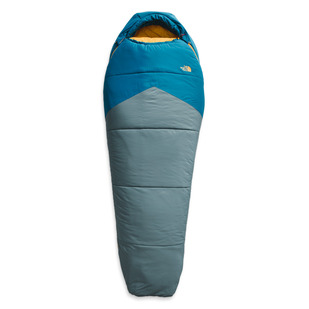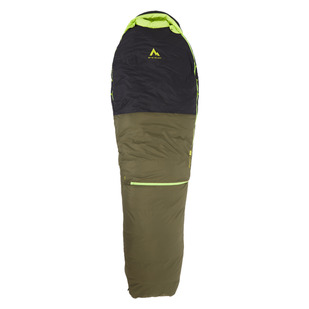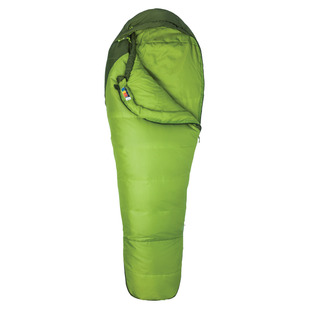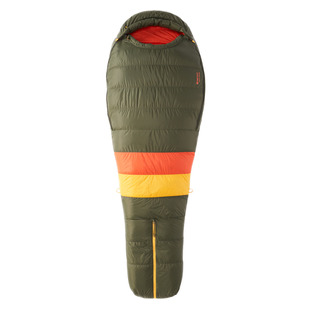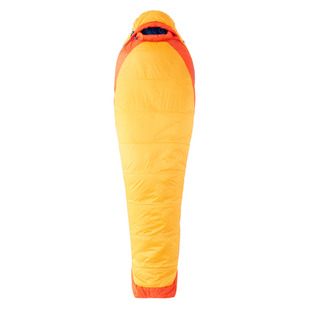What could be more comfy than lazily setting down into your sleeping bag at the end of a day in the great outdoors? It is however important that a sleeping bag meets the needs of the user. Here are some tips to help you find the right one for you.
Consult our guide to help you choose the right sleeping bags.
1. Buying
Whether you are a summer or a winter camping enthusiast, there is a sleeping bag that will meet your specific needs. But before buying one, you should look at the following:
- comfort rating, or ability of the sleeping bag to provide comfort at different temperatures;
- recommended insulation (synthetic or down);
- bag shape.
Comfort rating
In general, there are three types of sleeping bags:
- summer season, for temperatures above the freezing point;
- three-season, for use in temperatures down to -10°C;
- winter, which allows you to sleep without shivering in temperatures as low as -40°C.
There is also a fourth category, the four-season sleeping bag, whose comfort rating is between -15°C and -20°C. But these bags are too hot for use in summer, and we often group them together with winter sleeping bags.
To choose the right bag, you must think about how you will be using it over a given year, and identify the best comfort rating for a given user. A persons metabolism, diet and tolerance to cold are just some of the factors that should influence the final choice of sleeping bag. Thus, a person who is sensitive to the cold would be better off choosing a warmer sleeping bag, even if he does not plan to use it in low-temperature conditions.
Insulation
The quality of an insulation material is determined by its ability to retain air, which is not a good heat conductor. The more insulation can easily trap air, the more the sleeping bag will remain comfortable in lower temperatures.
Although many synthetic insulations have become increasingly effective, down remains the best insulation around: in fact, there is nothing warmer or more comfortable for a sleeping bag. As well, down sleeping bags have better compressibility, which makes it easier to carry and leaves more space in your backpack for other things.
However, down does have a downside:
- when wet or soaked, it loses its ability to trap heat;
- it takes a long time to dry;
- it is not recommended for people with allergies;
- it is more expensive.
Synthetic insulation is heavier, not as compressible and does not last as long as down, but is not as expensive. However, synthetic insulation do not absorb water as much, thus maintaining its heat index easier and drying quicker. As a result, it is are less prone to mildew.
Shape
Sleeping bags come in three shapes on the market:
- mummy: this bag hugs the body, has a hood and is more fitted around the heels and feet, which means body heat is retained quickly and effectively. But some may find it too body-hugging and may prefer a modified mummy bag (with more interior space) or a barrel sleeping bag;
- barrel (or semi-rectangular): this bag is a compromise for people who do not want to feel too confined without sacrificing the insulation capacity of the sleeping bag. However, it is bulkier and heavier than the mummy bag;
- rectangular: even heavier and bulkier, this type of sleeping bag is ideal for those who need more space or who wants to zip sleeping bags together. This simply built bag is also the least costly of them all.
Once you have chosen the sleeping bag shape, you must look at the exterior shell. The shell has three functions:
- to keep insulation in place;
- to serve as a wind screen;
- to allow internal transpiration to escape.
More often than not, the shell is made of a ripstop nylon (which prevents tears from becoming larger) or taffeta. Nylon is light and therefore must be tightly woven to prevent the insulation from accumulating in a corner of the bag, as well as to minimize wind infiltration.
The inner lining must be able to breathe and easily evacuate humidity. Therefore, it is not recommended to use cotton or poly-cotton, which becomes soaked easily.
To prevent cold from entering through the seams, insulation layers must ideally overlap and not be sewed edge to edge. For down, it is sometimes recommended to create small stitched boxes, which are sewn in the shell lining to stop the down from settling in one spot and to prevent cold air from entering.
Some manufacturers add more insulation in places where the body more easily loses heat, especially around the extremities (feet and head). Ideally, the sleeping bag should also have an inner neck opening to keep heat in around the neck and shoulders. Preference must also be given to bags designed with an insulated protective hem along the zipper to prevent cold air from entering. Ideally, it should be sewn starting at the lining and not the shell.
Zippers should be cable stitched and made of nylon, which is lighter, easier to handle and less likely to get stuck, unlike "teethed" zippers.
As for length, it depends on what the buyer will use it for: some people like to keep certain items (clothing, flask, etc.) at the end of the sleeping bag to keep them warm. But one things for sure: to know whether a bag meets the users expectations, simply try it on for size, as you would with a piece of clothing.






